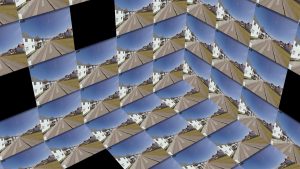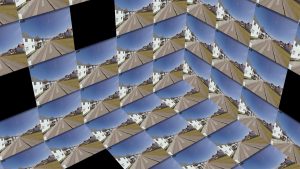

More often than not, we think of change as something to plan for. Or something that just occurs when we least expect it. Consider these examples that seem to be dichotomies.
Growing up in India, living and travelling within the country, I am, as are most of the citizens of the country used to constant change. From roads that disappear overnight to the continued kindness of strangers. The sudden gesture of empathy from the state versus the closure of your favourite tea stall. As a member of an incredibly large country, you get used to change. Almost as if change becomes a constant. A pre requisite. A fact of life etc.,
I’ve recently returned from completing an MA in London. A change of pace? Sure. However, my propensity for change and chaos, either put me at an advantage or a severe disadvantage. Suddenly I was creating binaries where there were none. Every morning, I half expected a road outside my house to be dug up, for a bus to be late or broken down. Or even to suddenly told to leave the country. Change, it seems, eluded me.
While it is futile to debate over which of these is a better environment to engage in artistic discourse, I did however learn one surprising thing. That my environment allowed for constant learning irrespective of the geographical location.
Prior to studying art, I freelanced as a photographer, filmmaker and a motorcycle entrepreneur. And even before that, I was a banker. All of these roles were the result of conscious decisions to be those things. But it seemed, I was missing the point entirely while searching for the thing I wanted to do most. I was entrenched in the knowledge systems regarding each of those roles I was playing, yet had no idea how to find the lines that connected them. Any street wisdom I picked up from being a long distance motorcycle traveller, I tended to separate it from the other things I was trying to be.
By isolating my experiences, I was unable to see what was the one important factor connecting all of them – me. At the risk of sounding narcissistic, I will elaborate. While studying the works of continental philosophers such as Deleuze and Guattari, Lacan, Foucault etc., I found that I was pre-disposed to a binary form of thinking. Either this or that. The conviction in my beliefs often led me to ignore/disregard any other points of view or stream of knowledge that was “other” than mine.
As someone who had never read a word of art history or critical theory or even have a basic set of drawing skills, I tried to find ways to improvise. Diving deep into the works of Deleuze and Guattari, especially “A Thousand Plateaus” within which I discovered their interpretation of the Rhizome. The Rhizome offered me a way out of my binary thinking processes. By allowing for multiple connotations of a thought to exist at the same time and at different times, i.e – multiple points of view regarding the same subject, arising from the same place or multiple places at various times, knowledge can then seep in without constraint. Knowledge as a term is subjective. To achieve any sort of true dissemination, we must first free it from its perceived hierarchies.
By allowing for chaos to enter our systems of knowledge, we enable it to welcome the unexpected. To embrace it and continue to propagate itself.
Here's an audio piece from a work I made last November that might help to grasp the text a little better - https://soundcloud.com/vishalkswamy/state-of-affairs_introspection_violence

Hello Vishal,
Your experiences and ideas of how the “changes” impact on you as an artist reminds me the new media piece Waiting for a GPS Signal by Nouf Alhamdan.
“Waiting for GPS signal is a metaphor that opened new possibilities to explore issues of dual-identity in which Alhamdan is cast as an outsider from her birthplace and family ties to Saudi Arabia and from her education home in the United States. The emotional quest led to producing artwork that highlights issues of positionality, culture, gender, globalization, and double coding. Alhamdan discusses these artworks raising concerns of racial stereotypes. GPS, in this exploration, references: (G) for gender global positioning, (P) for her positionality, and (S) for socio-cultural systems and signals. Aiming to deconstruct globally social norms and replace them using her position as a previously isolated Middle Eastern female being bombarded with Western culture.”
You may be interesting to read the full article, and here it is:
http://vcg.emitto.net/index.php/vcg/article/view/108/110
Dengke
Thanks a lot Dengke! I was not aware of this work and I’m currently reading about it. A work that has affected me greatly is Lawrence Abu Hamdan’s Language Gulf in The Shouting Valley “Language Gulf In the Shouting Valley (2013) is a 15 minute audio essay ( 3 minute extract above) and audiovisual installation about the politics of language and the conditions of voice faced by the Druze community living between Palestine/Israel and Syria. Recordings of the Druze Soldiers working as interpreters in the Israeli Military Court system in the West Bank and Gaza are contrasted that with recordings from the Shouting Valley, Golan Heights, where the Druze population gather on both sides of the Israeli/ Syrian Border and shout across the jurisdictions to family and friends on the other-side. By Inhabiting the border between Syria and Israel and Palestine the Druze complicate the solid divide. If we listen closely to the oral border produced by this transnational community, in one voice we can simultaneously hear the collaborator and the traitor; the translator and the transgressor. ”
By amplifying the oral border, he was able to allow for the possibility of accidental synchrony
http://lawrenceabuhamdan.com/#/langugae-gulf-in-the-shouting-valley/
Vishal, there are so many trajectories in your post that either draw me to re-inspect my own understanding of binaries, or leave me with the thought that it is lovely to have another see things the same way sometimes.
Creating binaries where there are none, a thought that not only makes me think of D and G’s rhizome (I too spent a lot of time rather mesmerized by Thousan Plateaus) but also of Jameson’s ideas regarding duality, reminds me of the practice of Doris Salcedo. Though she does not as such force binaries upon places, her installations gradually call upon binaries that once existed, giving them a space for remembrance in the present by invoking their essence.
Subjectivity of knowledge, and the lack of the absolute, are points of departure that are very close to home for me as well. Though it may be a stretch, I would like to venture into a space where the creation of binaries in power points becomes a tool for certain powerhouses to monopolize knowledge and try and establish an absolute. Like a colonial powerhouse had a way of creating a rift between various modes of knowledge, consistently stressing on theirs as absolutist in an attempt to completely disregarding existing ‘non-scientific modes, is it possible that the more forcefully a binary is created, the more it becomes a way for one to establish itself as superior and eventually absolute?
“By allowing for chaos to enter our systems of knowledge, we enable it to welcome the unexpected. To embrace it and continue to propagate itself.” This statement truly resonates, and though I would have never been able to frame it so before, I do think impulse and chaos are what allow me to oscillate between modes of knowledge and impulse, and give each their due outside of a space of judgement. Thankyou!
Also I think you may enjoy Frederic Jamesons texts which often take D and G a step further.
Sarasija, thank you so much for your take on this post. I’m really excited to meet a fellow reader of D&G, and looking through your posts and works, I take comfort in the notion that critical theory manifests itself in such a wonderful way. Although I am only vaguely familiar with Jameson’s texts (I am currently in the process of exploring them), I’m often drawn to find a middle ground so to speak between the need to adhere to binary notions and the Zen principle of Satori. The idea that we can align our inner dualities into a singularity makes me think of D&G’s views on rhythm. I’ve taken this strand of thought to try to answer your question (and perhaps have questions of my own) on the ‘creation of binaries in power points to monopolise knowledge and try and establish an absolute’. Regarding the method of creating binaries, I’m of the view that binaries occur naturally and a power structure attempting to weaponise them conflate binaries with prejudice. An example for me is the current state of political affairs in India where strong binaries have taken over the conversation by simply exaggerating the notion of ‘the other’, the other that questions the government, the other that doesn’t look like us/have the same faith/language/caste etc., and by simple virtue of being the other, a constant state of false rhythms exist. Looking forward to your responses!
The idea of inner dualities aligning into a singularity though intriguing, I still think I would lean towards ideas that talk of binaries (and even chaos) as ways to mobilize the self and others. For some reason, I do continue to err towards the side of the lack of the absolute or the singular, and I’m sure being a present generation Indian has a lot to do with it, politically and otherwise!
I guess I do agree, binaries readily exist, but don’t the bridges between the binaries also exist just as readily? The thought that binaries are being weaponized, though rather true, does make me parallely question whether all the binaries existed as such to begin with, and to what degree. Sometime the tension that stems from the binaries exists only below the surface, no? Also, false rhythm, I love that. Its such an oxymoron. Though I find it hard to in any way see the Indian political scenario as a rhythm of any sort, false or otherwise.
I find the fact that you have found yourself as a common thread to the changes that you went through as a factor which is to be recognised; at times we are very ignorant of the fact the we are the ones who have to travel our own journey. No matter how similar it is to someone else, we have the storytellers of our experience, and quit an achievement to be able to isolate yourself and review the changes that have helped shape who we are currently. Whether good or bad, these experience are key to the person we are right now.
thank you for your kind words. I am absolutely surprised that I was able to pinpoint these experiences and unravel them. Being able to see works of Mona Hatoum (Light Sentence, 1992) and Alexander Calder (Red and Yellow Vane 1934) was of great help to achieve a sort of inward clarity. Because Art is so subjective, work that moves you often does so in many different ways. Trying to understand a piece of work solely by the text that accompanies it is in a way avoiding the time we need to absorb the work. Being able to practice that kind of detachment from the work’s description definitely informs my practice as well.
Here are the images of the works I am talking about.
Alexander Calder
The binary way of thinking is very common, I would say that we are all predisposed to thinking this way, because it is the natural way of thinking, probably a product of evolution, that taught us to make distinctions/oppositions, in order to have more chances of survival. In many cases thinking this way is still very useful. But getting out of this either/or, this/that, black/white way of thinking, opens up fantastic new views.
I am looking back at the first post by Ushmita, where she says “Identity thrives on opposition, stereotyping, segregation, on alterity”. We tend to figure out who we are in opposition to what we are not, in opposition to “the other”. How do you think the rhizome paradigm can offer a better way of thinking about identity?
Thank you for your wonderful response Grazia. I agree with you regarding the need for binary choices as a survival mechanism. I am further excited by the prospect of exploring thoughts about identity.
To begin addressing identity in response to your statement about it existing in opposition to “the other”, I would like to bring the Hegelian understanding of “the other”. In his seminal book “The Phenomenology of Spirit”, he states “Self-consciousness is the awareness of another’s awareness of oneself” which can be understood as we become aware of ourselves by seeing ourselves through the eyes of another. In a way Hegel states that the notion of “self” only exists in relation to “the other”. The interesting thing about this view of “the self” is that is often a contemporary understanding of “our identity”. An identity that exists in relation to what we perceive it to be. This deduction transcends any ethno-geographical boundaries and results in similar interpretations across languages as well.
That being said, I am further intrigued by Lacan’s reinterpretation of Freud. In his book “The Mirror Stage” “Lacan proposes that human infants pass through a stage in which an external image of the body (reflected in a mirror, or represented to the infant through the mother or primary caregiver) produces a psychic response that gives rise to the mental representation of an “I”. The infant identifies with the image, which serves as a gestalt of the infant’s emerging perceptions of selfhood, but because the image of a unified body does not correspond with the underdeveloped infant’s physical vulnerability and weakness, this imago is established as an Ideal-I toward which the subject will perpetually strive throughout his or her life.” This is an exciting insight into the birth of the self as an image and an “image of our identity”. Thus, “the self” now has an image in mind to further construct, remove aspects that are undesirable and to change itself to be as close a representation of this image as possible.
My problem with this understanding of identity is with the continuous replication of “the self-image” that gets entangled in a loop. As we start to define our identities in relation to 1. Ourselves, 2. Our immediate environment, 3. Our societal structures and so on, we are unable to release this image and instead find new ways of polishing it to our perception of it. By attempting to stop fulfilling our desire to become “the image”, we can then explore a multiplicity of “images” within our identity. A slow process of breaking down the nodes to this image and instead examining the nodes themselves allows us to redefine our own understanding of “the self”. An example is if we identify ourselves to be a “South Indian Artist” (in my case), I am restricting myself to a certain cultural image. While this isn’t an inaccurate description, I would want to examine the “South Indian” node along with the “artist” node. I will then also want to explore other identity tags that I can categorize myself under. “Indian Artist”, “Artist working with Moving Image” etc., But this is exactly the trap of representation I must avoid. By searching for definitive tags that can position me in a certain way, I have failed at understanding the purpose of the Rhizomatic notion of Identity which is that “Identity is not fixed, it is not a definitive answer to who or what the self is”.
I will stop this post here as I would like to enable a dialogue between the artists on the platform.
Looking forward to some more responses!